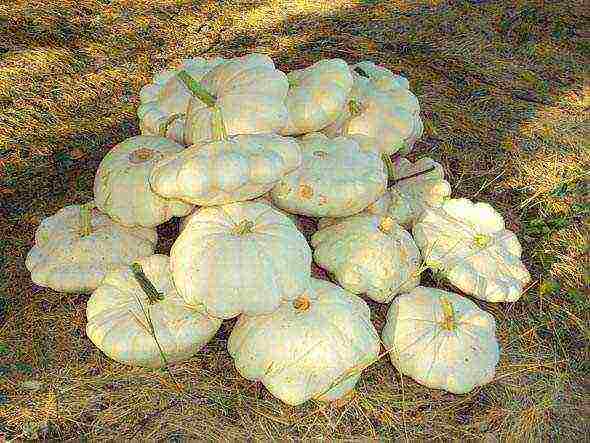Content [show]
Patissons attract attention with a decorative type of fruit. Like the closest related crops - pumpkins and zucchini - they do not cause much trouble during the growing season, but they love warmth. The quality of the crop is influenced by the correctly chosen planting site, the timing of sowing in the ground, compliance with the irrigation and fertilization regime.
Varietal assortment of squash for open ground
Patissons are represented by numerous varieties and hybrids. Varietal differences depend on the appearance, color and weight of the fruit, ripening period. The cultivation of squash in the form of a bush is widespread, although there are varieties with developed additional shoots - whips. The taste does not really depend on external characteristics, there are similar notes in all variants. The varieties are divided into early ripening, mid-ripening and late-ripening. Fruits of all ripening periods can be of different shapes:
- bowl,
- bell,
- disk,
- plate,
- with teeth,
- without teeth.
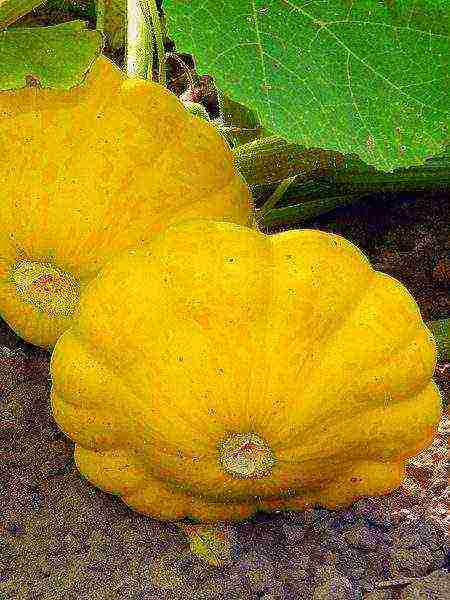
Patisson variety Tabolinsky has the shape of a plate with small cloves
The color of the fruits of this vegetable is also varied, sometimes so unusual that it can serve as a decoration for the garden:
- yellow,
- white,
- green,
- with stripes or spots.

Patissons of the Gosha variety of an unusual dark green color with white dots in color by the time of maturity become very dark, almost black
Early, ultra-early varieties and hybrids
They are appreciated for the short period of time that passes from the moment of germination to the harvest of the first harvest, which is 35–55 days.
Table: characteristics of early and ultra-early varieties of squash
Photo gallery: early and ultra-early varieties of squash
Mid-season varieties
The technical maturity of mid-ripening varieties of squash occurs when the plant reaches 50-60 days of age.
Table: characteristics of mid-season varieties of squash
Photo gallery: mid-season varieties of squash
Late varieties and hybrids
Patissons are thermophilic.For this reason, in the Moscow region, where the weather is unstable, spring is often cool, and summer is rainy, varieties and hybrids of late harvest dates are not widespread. The vegetative period of such plants is 60–70 days from germination to the first ripe fruits.
Features of planting squash in the open field
In the garden, a place for squash is prepared in advance, in the autumn. For planting, you should choose a sunny, wind-protected area. A southern, southwestern location is suitable.
Soil preparation
For squash, neutral soil acidity is important. Deoxidation is achieved by adding wood ash in the amount of one bucket (10-12 liters) per 1 m2 or liming the soil with dolomite flour (the application rates are indicated on the package, they depend on the acidity of the soil). Loose chernozem or non-acidic loams are suitable.
When calculating the rate of application of dolomite flour per garden bed, the acidity level and soil composition are taken into account
Soil preparation consists in deep digging of the selected area. At the same time, earth clods do not break. Along the way, mineral and organic fertilizers are applied (superphosphate, wood ash, manure, peat, humus). Spring work begins with repeated digging, crushing overwintered clods, loosening the top layer of the soil.
Planting dates with seeds and seedlings
Sowing squash with seeds in the ground can be done when the soil warms up to 10 ° C and above. At temperatures above +14 ° C and above, germination will go faster. For the Moscow region, this is usually the end of spring and the beginning of summer. Seeds are sown directly to the prepared place. In each hole, 2-3 seeds are placed at a depth of 6 cm in light soil (for example, sandy loam) or 4 cm in dense and heavy soil (for example, in clay). Top crops are sprinkled with a layer of peat to maintain soil moisture. After the emergence of seedlings, the plantings are thinned out, leaving one (less often two) strong sprout. The rest are either destroyed or transplanted to free areas.
It is important to keep track of spring frosts, which are detrimental to heat-loving crops. If there is a threat of frost, the bed with squash must be covered with a spunbond with a density of at least 60 g / m2.
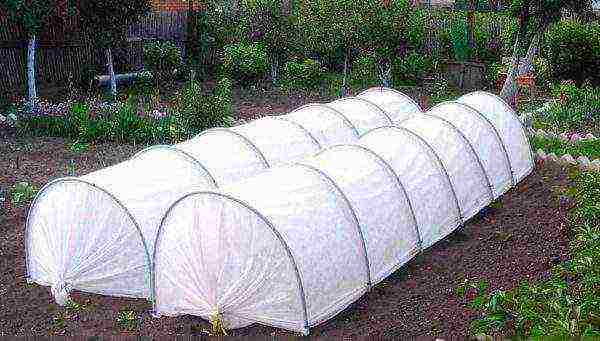
With the threat of frost, the bed with squash is closed with spunbond
To obtain an earlier harvest, seedlings of squash are grown at home or in a greenhouse. Using this method allows you to get fruits 20-25 days earlier. Seeds are sown on seedlings about a month and a half before transplanting mature seedlings under the open sky (mid or late April).
Seedlings are transplanted into open ground at the age of about six weeks. By the time of planting, there should be at least three true leaves on young plants. Relocation to a permanent place occurs at the end of May and the beginning of June, with the obligatory preliminary hardening of young growth on a glassed-in balcony or cold veranda. After a week, the sprouts are planted in the garden at a permanent place. The garden bed must provide shelter from cold nights and return frosts. To do this, use film opening greenhouses, spunbond. Warm beds are well suited for squash. Heating on them is carried out from below, due to manure or humus, placed under the upper earthen layer. Such a bed heats the plant throughout the season, while feeding it with organic feeding.
Landing scheme
Plants are placed on the site in a tape way or nesting (in squares). The placement option is selected taking into account the possible size of an adult bush and the shape / size of the garden bed. For a narrow bed, it is convenient to form one or two rows. A wide allotment provides an opportunity to choose any of the proposed planting schemes.
Table: schemes for placing patissons in the garden
Photo gallery: from the first shoots to flowering
The best neighbors and predecessors for squash in the garden
Correctly selected neighbors in the garden will provide the squash with a protective barrier from pests and increase the yield:
- marigolds planted nearby, nasturtium will save from the invasion of aphids;
- garlic growing in the same garden will help prevent powdery mildew;
- potatoes with corn affect the yield of squash and increase the duration of fruiting. Although there is no unambiguous opinion about the neighborhood next to potatoes;
- radishes and squash mutually complement each other when planted together;
- on the site of early varieties (after harvesting), planting of green manure is practiced, which allows the use of the land without downtime.
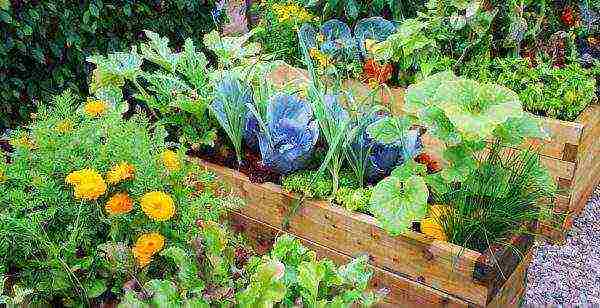
Marigolds planted next to the squash will protect the plants from the invasion of aphids
For squash, as well as for other garden plants, favorable and undesirable predecessors are characteristic. Good soils after nightshades (potatoes, tomatoes), greens, legumes, onions, radishes, cabbage (Beijing, cauliflower), siderates (oats, mustard, phacelia).
It is worthwhile to be afraid of using places from which the harvest of related crops (zucchini, cucumbers, pumpkins) was harvested in the previous season. In addition, it is not recommended to place them side by side during the growing season. This will provoke cross-pollination, which will further lead to a loss of varietal qualities in the obtained seeds. However, if the collection of seed from your own plants is not important, then related crops will serve as additional protection from weather manifestations (wind).
Care basics
Squash care includes the following procedures:
- loosening and mulching, weeding,
- thinning,
- pollination,
- protection of fruits from excessive moisture,
- watering,
- top dressing.
Loosening, weeding, mulching
From the moment of planting and until the plant is removed from the garden, it will be necessary to regularly weed the bushes, preventing the weeds from drowning out both young growth and adults. Loosening the soil around the bush is rarely used and superficially, trying not to damage the roots. Exposure of roots is eliminated by adding soil, mulching (the latter helps to reduce the amount of loosening and weeding). Sawdust, peat, humus are used as mulch.
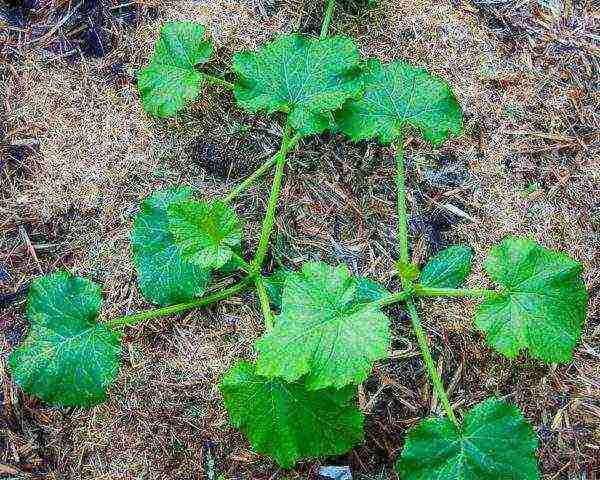
It is convenient to use cut and dried grass from the lawn as mulch for squash
Thinning
The abundance of large, strong leaves affects the qualitative and quantitative composition of the crop. Thickened bushes are thinned out by cutting off one or two old leaves at a time. The procedure is carried out in the morning, with an interval of 2 to 4 days.
Pollination
Cloudy, rainy weather during the growing season also adds complexity. In such weather, pollinating insects do not fly over blossoming flowers, pollination does not occur. You have to "work as a bee" yourself, manually pollinating each open female flower with a male one.
Video: manual pollination of plants using pumpkin as an example
Protection of fruits from moisture
Fruits, depending on the purpose of use, are harvested either small, so-called technical ripeness, or waiting for biological ripeness (that is, when the fruit has reached the color and size required for the variety). If heavy fruits lie on the ground, it is advisable to make supports under them so that they do not rot. On a mulched bed (especially if a black spunbond or black film acts as mulch), the fruits also remain dry and clean.

The fruits of the squash lying on the ground are lifted with the help of special props to prevent decay
Watering
Regular watering is carried out throughout the entire life cycle of the plant. The phases of development of squash affect the volume and time interval of moisture. From the emergence of sprouts to the onset of the flowering pore, they are watered once every 5-6 days, after waiting for the soil around the bush to dry out. The volume of water used is 6–8 liters per m2. From flowers to full ripening, moisture consumption increases by a couple of liters. The frequency of watering leaves once every 3-4 days.
Water is used standing, heated to 23 ° C. The temperature of the liquid is important as cold watering is dangerous for the plant. It weakens the defenses of squash and leads to disease. Water the squash gently. Do not allow liquid to get directly on the plant. For convenience, grooves are made around each bush. To retain moisture in the soil, each watering is completed by laying a layer of mulch.
Nature makes its own amendments to the planned schedules and modes. A dry hot season will add the amount of irrigation carried out; in cold, damp weather, it is worth taking care of the prevention of excess moisture and hypothermia of the grown crop, i.e., reduce the number of waterings and cover the plants with spunbond at night.
Top dressing before planting and during growth
Preparatory tillage (application of mineral and organic fertilizers) before planting provides the squash with useful substances for the entire growing season. In other cases, the use of fertilizers is carried out at least twice a season. For the first time, young vegetation is fed, which has developed four adult leaves. One of the working solutions is used:
- Agricola-5 (25 g of the preparation per 10 l of water) - the volume obtained is sufficient for watering from 10 to 20 m2 of area;
- a mixture of 20-25 g of potassium salt and 50 g of superphosphate (for 10-12 liters of water);
- Harvest, Kemira-universal or Growth II (25–30 g per 10 l of water), 500 ml for each plant.
The second time feeding is carried out during the period of bud emergence and ovary formation. It is better to use organic fertilizers - any of the proposed options of your own choice or on the advice of experienced gardeners:
- one part mullein to 10 parts water, with the addition of potassium sulfate (20 g) and superphosphate (15 g);
- one part poultry manure to 15 parts water.
For the third time, if required, fertilizers are applied after two weeks from the previous feeding. Use solutions of complex mineral preparations, as in the first application, or an ash solution with urea (a glass of wood ash, a tablespoon of urea in a bucket of water). Consumption is from one and a half to two liters per plant. When applying top dressing, overfeeding of the culture is unacceptable. An excess of organic matter - namely nitrogen - leads to abundant growth of lashes and leaves, which can negate all efforts to obtain a crop.
Video: caring for squash: how to achieve a large harvest
The choice of varieties of squash for the Moscow region
The mild climate of the Moscow region by no means contributes to the rapid growth of thermophilic crops. Taking this fact into account, it is better to grow early maturing varieties and hybrids with indicators of increased cold resistance in the region. The richness of the assortment gives the gardener the opportunity to choose a variety both by color and by ripening time. The best representatives of the species for the Moscow region:
- White:
- Disk,
- Cheburashka,
- Umbrella,
- UFO white,
- White-13.
- Colored:
- Piglet,
- UFO Orange,
- Sun,
- Chunga-Changa.
Reviews of gardeners
Among the reviews of those who regularly grow squash, there are often complaints about the germination of seed. Many complain about unexpected cold snaps, in connection with which the seeds stop growing and rot. Early white varieties have more positive responses. And the germination rate is 70%, and the ripening time is pleasing with the amicable return of the fruits. And summer residents really like the taste of squash.
Patissons do not require much effort when leaving. If you follow the recommendations for growing them, you can get a harvest of vegetables. But how big it will be depends on the gardener.
Good day! My name is Natalya. I am a mother of many children at the age of 41. Four years ago I changed the city to the village. I am mastering a personal subsidiary farm.
Squash is a thermophilic annual vegetable herb belonging to the Pumpkin family. Its name, translated from French, means "pie", which is associated with the non-standard shape of its fruits.Squash varieties differ in terms of ripening, as well as in shape and color. The most popular varieties are Orange, Gosha, Bingo-Bongo, Solnyshko, Yugoslavskaya Zvezda and UFO. The fruits can be in the form of a bell or a disk (plate), and in color you can find yellow, white, orange and green shades. The delicate flesh of the squash is very reminiscent of an ordinary zucchini. This vegetable is considered not only tasty and nutritious, but also contains a large amount of vitamins and minerals.
Squash can be grown in a seedling and non-seedling way. For a vegetable crop, the planting site (with a sufficient amount of heat and light), the proximity of groundwater and the composition of the soil on the site are of great importance.
Planting seeds for seedlings at home
Seed selection
Freshly harvested seeds are not recommended for planting. The only exceptions are last year's seeds, which were dried in the open sun for several hours or were treated with high temperatures (from 50 to 60 ° C). When purchasing seed material in specialized stores, it is recommended to pay attention to the age of the seeds. Although they retain good germination for about ten years, the most suitable for planting are seeds of two or three years of age.
Seed preparation for sowing
The whole process of preparing seeds for planting consists of several important stages that will contribute to high germination and high-quality harvest in the future.
Culling allows you to identify and sort seeds of different quality. To do this, pour all the seed material into a container with a saline solution prepared from 200 ml of water and 2 tablespoons of salt. High-quality seeds will sink to the bottom in a few minutes, and unsuitable seeds will float to the surface.
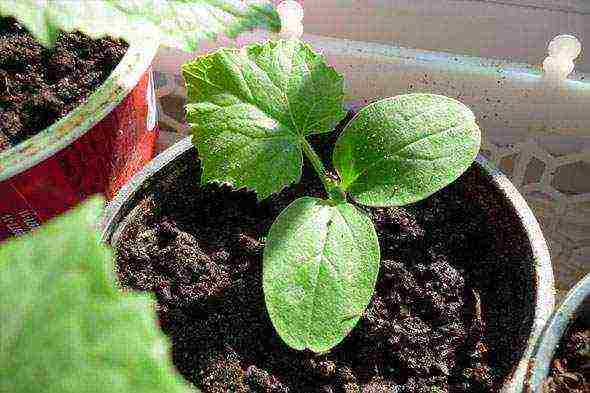
Good seeds should be left and allowed to dry before the next step.
Seeds are heated in two ways:
- within 5-6 hours in an oven preheated to 50-60 ° С,
- during the week in the open sun (or on a battery).
Planting material is soaked in special solutions. You can choose one of the options:
- ash solution (for 500 ml of water 10 g of ash),
- potassium permanganate (1% solution),
- water with aloe juice,
- ready-made stimulating solutions (for example, "Energen").
After this procedure, the seeds are washed and left under a damp cloth for 48 hours in a warm room.
After swelling in humid conditions, the seeds are sent for hardening in a cold place (with a temperature from 0 to + 2 ° C) and left there for 5-7 days.
The final stage of preparation is the germination of seed material, which lasts for 2 days. The seeds should be spread out on gauze on a flat plate, filled with warm water and placed in a darkened room with room temperature. Add water periodically. If there are sprouts with a height of 1.5 - 2 cm, you can proceed to planting.
Soil composition
5 parts of garden soil or peat, 4 parts of humus and 1 part of sawdust.
Selection of containers
You can use small plastic cups, flower containers, small plastic bags, or leftover food packaging (for example, glasses from yogurt, ice cream, kefir, juice).
Landing
Each seed is planted to a depth of 3-4 cm and sprinkled with soil mixture. The first watering is carried out immediately.
Place of cultivation
All small containers with seeds can be put in one large box and kept in a room with a temperature of at least 24-25 ° C during the day and 17-18 ° C at night.
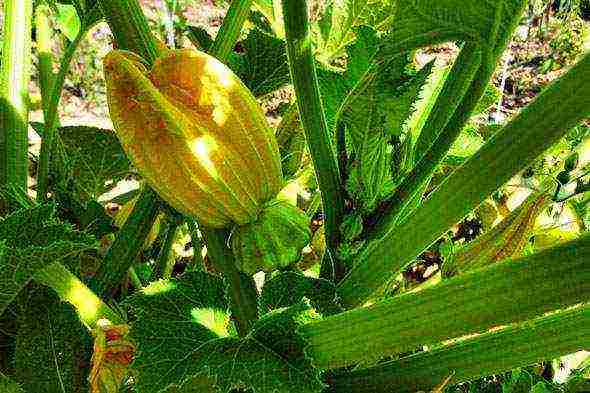
When and what to cover
The planting cover is needed to maintain moisture in the soil. It is left until the seedlings appear, after which it is removed.
When to plant seedlings
The most favorable time to start growing seedlings is the last week of April or the first week of May.
Care for seedlings of squash
Watering
Watering young plants should be moderate and sparse.One watering every 2 days will be enough.
Airing
It is recommended to ventilate regularly after each watering, but cold drafts for plants are very dangerous and should be avoided.
Top dressing
The first top dressing is applied 10-15 days after the emergence of seedlings, and the second one is applied before planting seedlings in open beds. Top dressing No. 1 consists of 1 part mullein and 10 parts water. Top dressing No. 2 - from 50 g of nitrophoska and 10 liters of water.
Hardening
Hardening of seedlings begins 5-7 days before transferring them to an open area. The volume of irrigation water must be reduced. It is recommended that containers with plantings be taken out every day in the open sun and left for 1.5-2 hours.
Transplanting seedlings into open ground
Terms and time of transplant
Only strong and strong seedlings with 3 full-fledged leaves and a low stocky stem with internodes are transferred to open beds. The approximate age of young crops is 3-4 weeks, that is, the transplant is carried out approximately in the first decade of June. A good time for planting is early morning or evening after sunset.
Temperature regime
Air temperature requirements for patissons - it should not fall below 19-20 ° C. Night frosts and very low temperatures should be gone.
Choosing a landing site
The plot of land for patisson beds should be open and sunny, without the slightest shade. The plant loves to soak up the sun and warm up well. The formation and ripening of fruits directly depends on the abundance of light and heat. The soil must first be dug up, loosened and fed. The acidic soil is not suitable for growing squash.

Top dressing
Fertilizer must be applied to each well. Mandatory nutrients are manure and wood ash. They need to be poured into holes (one handful of each), poured abundantly with water, and then the seedlings should be placed there.
Neighborhood with other cultures
Consideration of predecessor crops and neighbors in the beds will ensure a plentiful and high-quality harvest. Patissons grow well after:
- legumes,
- potatoes,
- tomatoes,
- cabbage,
- carrots.
The yield will increase when adjacent to
- radish,
- onions,
- garlic
- corn
- beets,
- dill,
- parsley.
Negative neighbors and predecessors are
- zucchini,
- pumpkins,
- cucumbers.
Planting process
The distance between plantings is from 50 to 80 cm. It is recommended to place young vegetable plants in the planting hole together with an earthen clod from the container in which they grew. This will ensure the preservation of the root part of the culture. In the first 3-5 days, the seedlings can be shaded so that the process of adaptation to new conditions takes place gradually.
Planting seeds in open ground
Seeds in open ground can only germinate at temperatures of 14-15 ° C during the daytime and from 7 to 8 ° C at night, at a lower temperature they rot. The optimal time is the second half of April.
Fertilizing the soil is carried out in the autumn and with the arrival of spring. Organic fertilizing can be applied in the fall when digging future beds. In the spring, after removing weeds and leveling the surface, complex mineral fertilizers can be applied. Spring soil nutrition should be carried out 4-5 days before sowing seeds. At the time of planting, you can add a little crushed eggshell to each hole.
Planting method, seed consumption
You can sow patissons in a checkerboard pattern. The distance between the holes is 60 cm, the planting depth is from 2 to 5 cm, depending on the composition of the soil. One hole - 3 or 4 seeds.
Care
It is very important that the irrigation water is settled during the day, does not contain chlorine and is not cold (temperature is about 25 ° C). The volume of water depends on the period of development of the culture. During flowering, 3 liters are enough for a bush, and during the formation of fruits, the volume must be brought to 5 liters. At the stage of ripening of the squash, watering must be reduced again to the original volume.Although squash loves abundant moisture, excess moisture is very dangerous for them. Before flowering, vegetable plants are watered every 5 days, then every 3 days.
Water needs to be poured only at the root, flowers and leaves cannot be moistened.
Weeding
Squash need weeding after heavy rainfall and as weeds appear. Every 4-5 days, it is recommended to remove the lower dying leaves, which can become a source of fungal disease and destroy the entire plant.
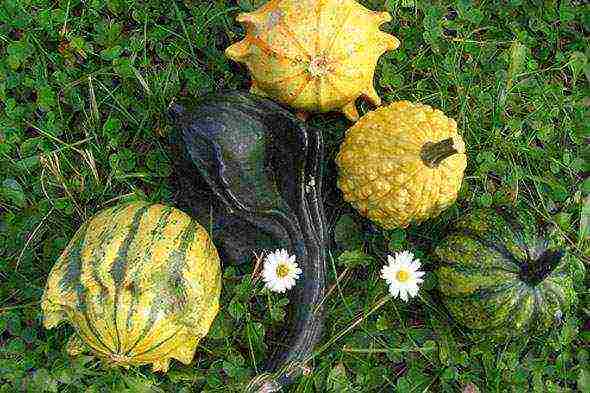
Loosening and mulching
Loosening of the soil is not necessary (due to the superficial root system of the squash), and the applied mulch layer (about 5 cm) will protect the soil from drying out and protect it from weeds. Mulch material -
- sawdust,
- peat,
- humus,
- cut grass.
Garter plants
Tying the patisson branches to the support is necessary to preserve the integrity of the fruits, since when they come into contact with the surface of the earth, they can become prey for pests (for example, slugs) or become infected with a fungal disease. Mold may develop on the fruit for a long time on damp ground. To prevent these problems, it is necessary to tie up varieties of crops with small fruits, and under the heavier fruits of another variety, small substrates of glass or plywood can be laid out.
Top dressing in the summer season is applied 3 times:
- before the flowers appear;
- after the formation of ovaries;
- after the end of fruit formation.
You can use an organic fertilizer consisting of water and bird droppings (or mullein). For every 100 g of mullein - 1 liter of water, for 100 g of bird droppings - 2 liters of water.
Diseases and pests
Major diseases:
- anthracosis,
- white rot
- root rot,
- gray rot,
- powdery mildew,
- white mosaic,
- fusarium,
- blackleg.
Probable pests:
- spider mite,
- whitefly,
- melon aphid,
- bear,
- sprout fly,
- slugs,
- winter scoop,
- root knot nematode.
Harvesting
If the fruits are necessary for collecting seeds, then they need to be harvested after the leaves on the bushes have dried. Squash, which will be eaten, must be collected in an unripe form, when the seeds inside have not yet formed. Such fruits have a delicate young skin, as if covered with a waxy coating. Their average size is 6 to 12 cm in diameter. Harvesting should be done regularly 1 or 2 times a week. It is recommended to cut the fruits together with the stalk.
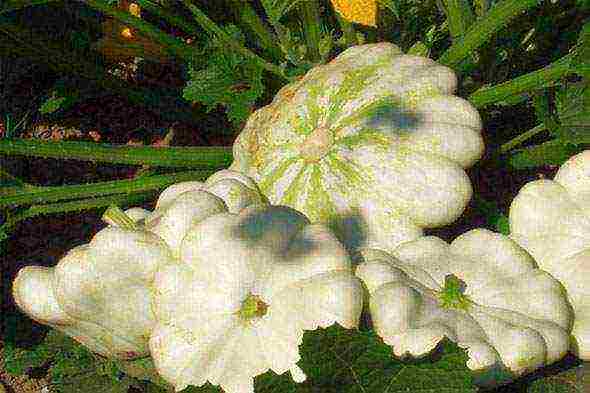
Patissons can be stored in a cool room with a temperature of 5 to 10 ° C for no more than 10-15 days.
They are stewed, fried, stuffed, baked, pickled and salted. Tinned, they are not inferior in taste to zucchini and cucumbers.
Before sowing the squash, you need to take seriously the preparation of the soil. Patissons are sown in an open, well-heated and ventilated bed. It is better to cultivate the soil in the fall. Fill the plot with organic fertilizer, and then plow or dig up without breaking clods of earth. In early spring, as soon as the snow melts and the soil dries up (ripens), break up the clods, then level the surface with a rake. If organic fertilizers have not been applied since autumn, then apply them in the spring, simultaneously with mineral fertilizers, a week before sowing, followed by digging the soil to a depth of 18–20 cm. After that, cut the bed with a rake. In central Russia, where there is a lack of heat, as well as early sowing in other regions of the country, the squash in the garden needs protection from the cold. What is this kind of insulated soil? In essence, this is the same bed, but warm, it is kept on a thick layer of organic matter, which heats it up. To set up a warm bed, a groove is dug in the ground, fresh manure or compost is poured into it, and a layer (20 - 25 cm) of fertile garden soil, watered with a solution of mineral fertilizers, is placed on top. When the soil temperature drops to 28–30 °, sowing is started.
If the soil is acidic, about which weeds such as horse sorrel, horsetail and wood lice "signal" on the site, then in the fall it is necessary to produce lime.
The timing of sowing seeds depends on the growing area, weather conditions and the type of insulated soil. For the Non-Black Earth Region, this is usually the 2-3rd decade of May or the 1st decade of June, when the threat of spring frosts will disappear. When using insulated soil and various film shelters, sowing begins 2 weeks earlier.
If sown in dry weather, then the seeds are embedded directly into the soil, followed by compacting the surface of the ridge with a shovel or a special board - the technique helps to pull moisture from the lower layers of the soil to the surface, where the seeds are located. Typically, the seeding depth is 5-7 cm on light soils and 3-4 cm on heavy soils. One plant of the Bely 13 variety and two plants of varieties and hybrids of an intensive type are placed per 1 m2. Sprinkle the surface with peat or cover it with plastic wrap, this will improve the hydrothermal regime of the soil. Immediately after sprouting above each plant, make a cruciform cut in the film.
Soaked seeds are sown in moist soil. The seed is soaked for no more than a day. This simple procedure speeds up the emergence of seedlings and enhances the initial growth, which ultimately reduces the likelihood of damage to the seedlings by pests and diseases.
An interesting technique is seed germination. Seeds pre-germinated in a warm place are sown into the ground; sowing is watered with water at room temperature, sprinkled with peat or covered with foil. Reception noticeably accelerates the overall development of plants in the initial period of their growth.
Of course, with the help of seedlings, you can "spur" the entry of the squash into fruiting, increase the early and total yield. The duration of growing squash seedlings, depending on the terms and conditions, is 15-30 days. In some cases, 40-day-old seedlings are also used, but during the growing period it is necessary to thin them out, leaving 20-30 plants per 1 m. Seedlings are grown in peat-baked cubes with a side of 10 cm. A mixture of fertile garden soil and well-decomposed low-lying peat with the addition of loosening materials (10-15% straw, sawdust, etc.) is often used as a substrate. When growing seedlings on a peat substrate, it must be neutralized with wood ash (30-50 g per bucket). For the same volume, it is desirable to add a matchbox of urea, two boxes of superphosphate and 1.5 sulfuric acid or 1 box of potassium chloride (the same recipe for cucumber) ..
Sow with pre-soaked, germinated seeds before pecking, placing 2 in each pot. After emergence, the weaker seedling should be cut at the level of the soil surface.
You can sow seeds first in sifted and steamed sawdust, and after the emergence of shoots, dive one plant at a time into cubes or pots with soil mixture. Seedlings ready for planting have 2-3 true, normally developed leaves and a shortened hypocotal knee.
In practice, sometimes both methods are combined. If you use only the seed method, then it is advisable to grow an insurance fund for seedlings (10-20%). When using the seedling method, in case of poor survival or damage to plants by frosts, pests or diseases, it is necessary to sow seeds in place of fallen plants, thereby increasing the efficiency of land use and the yield of squash.
Increasingly, amateur vegetable growers prefer to grow squash under various temporary film shelters. The film allows you to improve the hydrothermal regime and microclimate in the shelter, sow seeds or plant seedlings 2 - 3 weeks earlier, and ultimately get the tender fruits of the squash with a significant advance, significantly increase the yield both by creating a more favorable microclimate and by lengthening fruiting period.You will get good results when combining temporary shelters with soil mulching with peat or film.
Since the squash is "picky" to excess air humidity, shelters need regular ventilation. If you use a perforated film, then the need for this time-consuming operation will disappear. They make holes in the film so that there are 500 holes with a diameter of 1 cm per 1 m2. An electric drill will help to quickly perform such an operation (the film is folded in several rows).
Good results are obtained by vegetable growers using thickened crops and planting to obtain an early harvest. After closing the plants in a row, the plants are thinned out (cut to the root) after one.
The most effective culture of squash in film greenhouses on a vertical trellis. The garter of squash plants in greenhouses is carried out in the same way as for cucumber plants. Remove lateral shoots up to a height of 0.5 m; higher, to a height of 1 m, leave 1 knot each, pinching the lateral shoots on the fruit, and even higher, to the trellis, leave 2-3 knots and the fruit. After reaching the height of the trellis, which usually occurs in 2 months of cultivation, twist the main shoot twice around the horizontal trellis, tie it to it with a hemp rope, and lower the top freely and pinch it at a height of 50 cm from the soil surface.
Caring for squash in the open ground, in film greenhouses and tunnels consists of regular watering of the soil under the plants, weeding, removal of the lower aging layer of leaves and rotted fruits. Watering is best done along the furrows, because when sprinkling, water gets into the flowers and on the ovaries, causing them to rot.
During the period of active vegetative growth of plants, 1-2 fertilizing with solutions of mineral fertilizers is carried out. You will get good results when using mullein (1:10) or chicken manure (1:20) at a rate of 0.5 liters per plant. This top dressing is sufficient for normal growth and fruiting of the squash.
Keep in mind that squash are cross-pollinated plants and for normal fruit setting they need pollinating insects (bees, bumblebees, wasps). In film greenhouses and tunnels, and in bad weather and in the open field, additional manual pollination is required. To do this, they pluck a male flower - a barren flower, tear off the corolla of a flower and insert it into a female flower - an ovary.
Harvest the fruits 2-3 times a week, when the fruits reach 5-7 cm for dessert use and canning whole fruits, 7-12 cm - for salad and table use and canning with slices. With regular collection of fruits, squash fruiting until the first frost, after which the plants are removed and used in green compost.
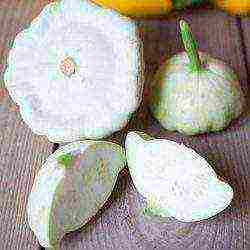 Patisson is a type of pumpkin, but to someone it tastes like mushrooms, and to someone - zucchini. Its varieties have a variety of colors and ripening periods. However, the technology of planting and further cultivation on the site, in the open field, the rules of care and breeding methods for them are practically the same.
Patisson is a type of pumpkin, but to someone it tastes like mushrooms, and to someone - zucchini. Its varieties have a variety of colors and ripening periods. However, the technology of planting and further cultivation on the site, in the open field, the rules of care and breeding methods for them are practically the same.
Description: varieties and varieties of squash
Those who see the squash only in the photo may think that this is some kind of exotic. In part, they will be right, because the homeland of this dish-shaped pumpkin is South America. The fruits of a herbaceous annual can look like a disc, a bowl or even a bell, have a different shape of the edges. At the same time, the taste of squash of all varieties is almost the same.
Traditionally, the vegetable has a white color, but thanks to the efforts of breeders, hybrids of other shades have appeared.
White varieties (all - early):
- Loaf - more than 2 dozen fruits can be harvested from one bush;
- Umbrella - its fruits reach a mass of up to 1.4 kg;
- Cheburashka - ripens in 35-39 days, resistant to cold snaps.
Yellowish orange:
- The sun is mid-season, with cream-colored pulp;
UFO Orange - has a high content of vitamin C, magnesium and iron, not picky about growing conditions.
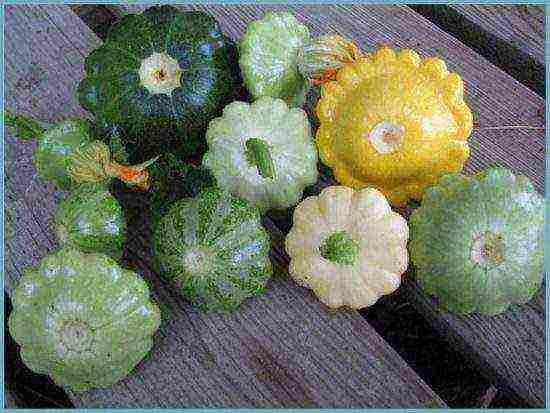
Squash of different varieties
Green:
- Gosha is an early variety; when the fruits ripen, their skin has an almost black tint;
- Chunga-Changa is mid-season and very productive, fruits can weigh more than 0.5 kg.
Violet - Bingo Bongo. It ripens on average in 6 weeks, the squash of this variety is juicy and large (up to 0.6 kg).
Planting seeds in open ground
In warm climates, it is best to practice growing squash from seeds. However, if the site is located in a cold region or you need to get an early harvest, a seedling planting method is suitable. The site must be well lit and protected from drafts: squash is a culture that loves warmth. Vegetable beds can be prepared in the fall. It is planted in fertile, loosened soil, the temperature of which is at least 10-12 ° C. When sowing outdoors, this is late spring or early summer, depending on the region.
Attention! If the soil is not warmed up, the seeds can rot.
An approximate landing pattern is 0.6 x 0.6 m, but it is possible less often. In each hole, it is worth lowering a few seeds to a depth of 3-5 cm if the soil is heavy, and up to 7 cm if it is light. The seed can be pretreated:
- hold for a day in a growth stimulator, then the same amount in a damp cloth at t + 20 ... + 25 ° C;
- warm up for 4-6 hours at t + 50 ... + 60 ° C;
- harden by wrapping in a cloth and keeping at t + 18 ... + 20 ° C (6 h), then at t 0 ... + 1 ° C (from 18 to 24 h).
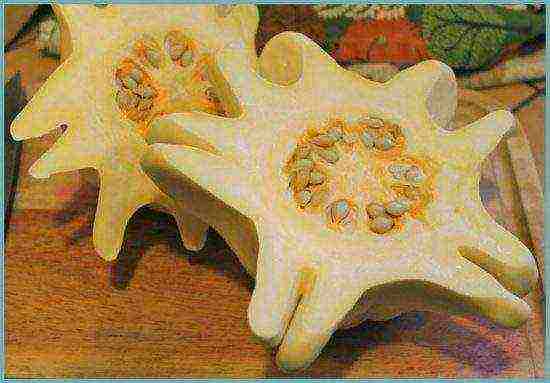
Most often, squash is planted with seeds.
Before sowing, it is worth keeping the seeds in a manganese solution, and then drying them. After planting, you need to lightly sprinkle each hole with peat and cover with a film. Watering should be accurate - drip better. When shoots appear, it is recommended to leave only the strongest shoots to prevent thickening.
Squash care
- Watering is regular throughout the season, but especially after emergence and fruit formation. The water should be warm. Care must be taken not to fall on leaves and flowers.
- Loosening is superficial and not frequent.
- Mulching - with a layer of up to 5 cm. You can take peat, humus, sawdust, then the soil after watering will not dry out quickly.
- If there is a threat of recurrent frosts and to protect against night cold weather, it is worth covering the beds with a film.
Attention! The optimum temperature for squash is not lower than + 20 ° C.
Fertilizing and feeding. What and when to use
If you want to harvest a good harvest, you cannot do without fertilizers. They need to be added 2-3 times per season. This is one of the basics of proper squash care. Apply a mineral fertilizer before flowering. During the period of fruit formation, use potassium salt as a fertilizer (50 g per bucket of water). You can take organics diluted with water: mullein (in a ratio of 1:10) or chicken droppings (ratio - 1:20).
No less important is the pre-fertilization of the soil. If the soil is acidic, in the fall you need to add lime to it (up to 0.6 kg per 1 sq. M). If it is slightly acidic, the ash introduced before sowing is suitable (30-40 g per 1 well). Clay and peat soil before planting squash should be fed with organic matter or minerals.

Squash bush
Plant propagation and growing seedlings
For propagation of this pumpkin vegetable, seeds are taken. They are taken out of ripe fruits and dried in a warm room. Most often, the collection of seeds occurs closer to autumn. Therefore, you need to provide them with good conditions and care: diffused sunlight and ventilation.
If you want to start growing seedlings from seeds, then in the middle of spring you need:
- pour nutrient soil into peat pots or plastic cups;
- add mineral dressing;
- put 2 seeds in each container (depth - up to 4 cm);
- withstand the temperature regime: + 25 ° C - during the day, + 18 ° C - at night. After sprouting, you need to lower the temperature by a few degrees, and after a week, increase it again.
Sprout care is simple: sparse watering and airing. In open ground, seedlings are planted around the beginning of summer.
Diseases and pests of squash
Insects:
- Spider mite. It affects the leaves. Its reproduction is fraught with the death of the plant.
- Melon aphid. Lives on leaves, flowers, ovaries.
- Sprout fly. Harmful to seeds and seedlings.
Fungal diseases:
- Powdery mildew. Covers the leaves with a white coating.
- White rot. From it, the fruits become soft and rot.
- Root rot. The roots and stems turn brown, the squash stops growing.
To know what a particular pest looks like or to distinguish symptoms of ailments, you can see photos of diseased plants. For treatment, you need to select bio or mineral preparations. And the best preventive measures are proper care, including weed removal.
Squash in the garden: combination with other plants
With proper planting, you can increase the yield of squash and provide them with protection from pests. To do this, you need to correctly select "neighbors" in the garden. A combination of this vegetable with onions, garlic, radishes and corn is considered good. Nasturtium, thyme, thistle, cucumber herb are useful for him. If you plant marigolds nearby, you will be able to scare off insects - for example, aphids.
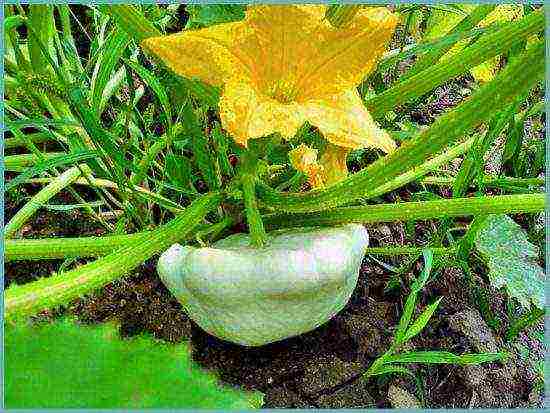
Blooming squash
Squash planted in the open field is recommended to be supplemented with cauliflower or Chinese cabbage, pumpkin, beans. The advantages are obvious: after harvesting some crops, you can plant others. At the same time, they do not interfere with each other and even facilitate care. For example, on a plot with squash all summer long you can grow dill and lettuce - their combination with each other is successful.
The varieties of this vegetable do not tolerate the neighborhood with potatoes, although they grow well in the place where the tubers have already been dug up. Also favorable predecessors for squash are tomatoes, cabbage, legumes, carrots. It is not recommended to plant it indoors or outdoors after "relatives" (zucchini, cucumber and pumpkin) and even next to them in order to prevent over-pollination. In this case, the seeds collected for propagation may not meet your expectations. Not the best solution - joint cultivation with beets.
Patisson produces crops continuously, so you can harvest it 2 times a week, so as not to delay the development of other fruits. And the taste of a vegetable with a delicate young skin is more pleasant than an overripe one. If the peel has already hardened, it is worth leaving the fruit for seeds. Such squash must be removed from the garden after the bush on which they grow begins to dry out.
Growing squash: video
Growing squash: photo



